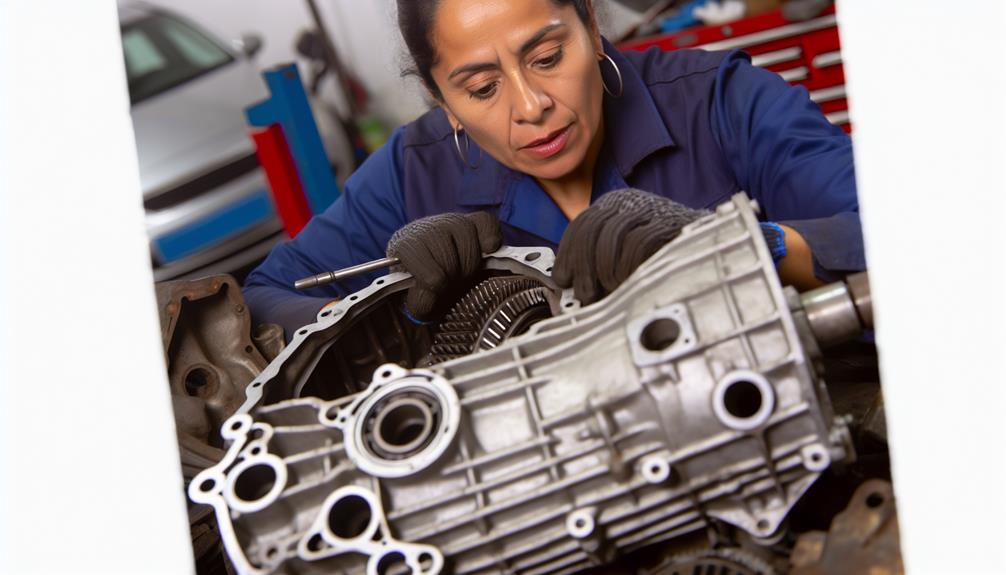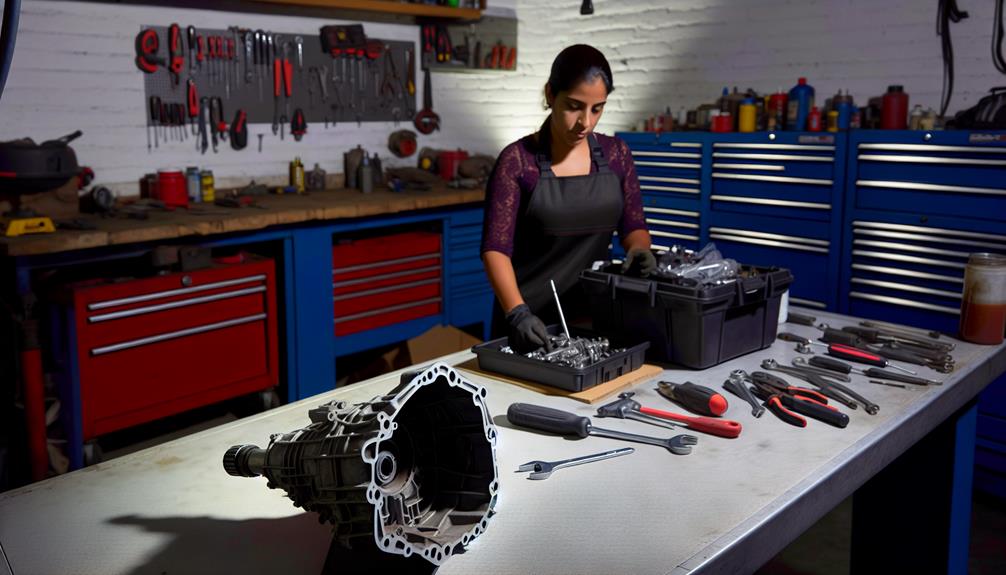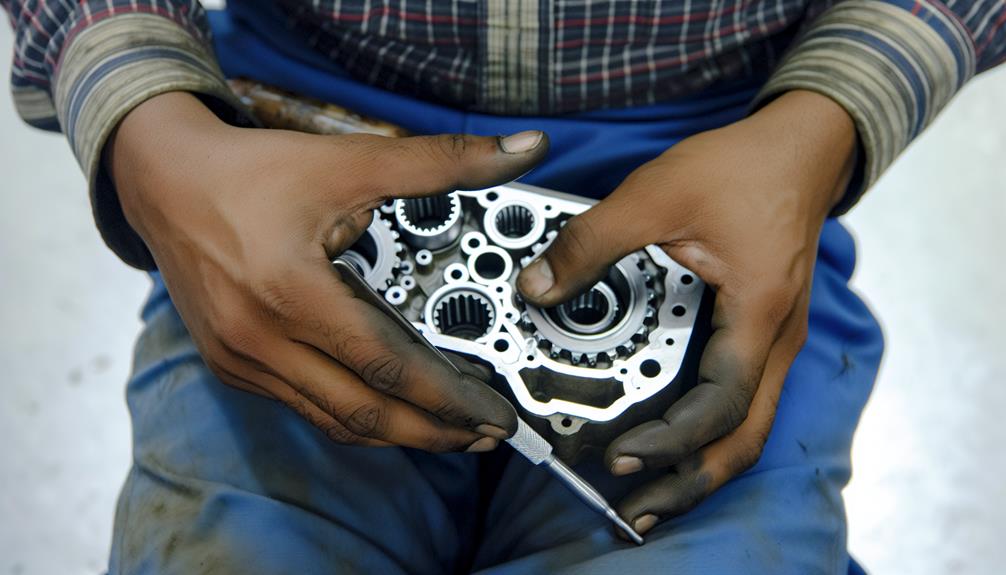Like a well-oiled machine, your vehicle's transmission is a vital component that keeps everything running smoothly. But just like any complex system, it can encounter issues that require the right techniques for repair.
From routine fluid maintenance to valve body inspection and repair, there are eight best techniques that will keep your transmission in top shape.
But what are these techniques, and how can they help you avoid costly repairs down the road? Strap in, because we're about to reveal the secrets to ensuring your transmission's longevity and performance.
Key Takeaways
- Regularly checking and changing transmission fluid at recommended intervals is crucial for maintaining the health of the transmission.
- Conducting diagnostic scans and assessments can help identify transmission problems and develop an appropriate repair plan.
- Common symptoms such as erratic shifting, leaking fluid, burning smell, and illuminated warning lights indicate transmission issues.
- Accurate diagnosis and repair techniques such as solenoid replacement, clutch adjustment, clutch replacement, and torque converter repair or replacement are necessary for optimal transmission performance.
Routine Fluid Maintenance
To ensure the optimal performance and longevity of your transmission, it's imperative to prioritize routine fluid maintenance. Regularly checking the fluid level and changing the transmission fluid are essential tasks that must be performed to keep your transmission running smoothly.
Firstly, it's crucial to regularly check the fluid level of your transmission. Low fluid levels can lead to overheating and excessive wear and tear on the transmission components. By checking the fluid level regularly, you can identify any potential leaks or issues and address them promptly.
Additionally, changing the transmission fluid at recommended intervals is vital for maintaining the health of your transmission. Over time, the transmission fluid can become contaminated with debris, dirt, and metal particles, which can negatively impact the performance of your transmission. Changing the fluid helps remove these contaminants and ensures that the transmission operates at its best.
When performing a transmission fluid change, it's essential to use a high-quality fluid that's compatible with your vehicle's specifications. Following the manufacturer's recommendations regarding the type and quantity of fluid is crucial to maintain optimal performance.
Diagnostic Scan and Assessment
To effectively diagnose transmission issues, you need to scan and analyze the system using specialized diagnostic tools.
This process involves connecting the scanner to the vehicle's onboard computer and retrieving error codes and other relevant data.
Once the problem is identified, a thorough assessment and diagnosis can be made to determine the exact cause of the issue and develop an appropriate repair plan.
Scan and Analyze
You can effectively diagnose transmission issues by utilizing diagnostic scan tools and conducting a thorough assessment of the system. Scan techniques and data analysis are crucial in identifying the root cause of any transmission problem. Diagnostic scan tools allow you to gather data from various sensors and modules in the transmission system, providing valuable information about the system's performance and any potential issues. Once the data is collected, a comprehensive analysis is conducted to pinpoint any abnormalities or malfunctions. This analysis involves comparing the collected data to known specifications and identifying any inconsistencies or deviations. By using diagnostic scan tools and conducting a thorough data analysis, you can accurately diagnose transmission issues and determine the most appropriate repair techniques.
To emphasize the importance of scan techniques and data analysis in transmission repair, consider the following table:
| Scan Techniques | Data Analysis |
|---|---|
| Scanning the transmission system using diagnostic tools | Comparing collected data to known specifications |
| Gathering data from various sensors and modules | Identifying any inconsistencies or deviations |
| Analyzing the performance of the transmission system | Pinpointing abnormalities or malfunctions |
| Utilizing diagnostic scan tools to diagnose transmission issues | Determining the most appropriate repair techniques |
Problem Identification
Problem identification in transmission repair involves conducting a diagnostic scan and thorough assessment of the system to pinpoint any abnormalities or malfunctions. This step is crucial in determining the root cause of transmission issues and ensuring an accurate repair plan.
When performing problem identification, keep an eye out for the following common symptoms:
- Erratic shifting: The transmission may shift gears unexpectedly or jerk while changing gears, indicating a potential problem.
- Slipping gears: If the transmission slips out of gear or fails to engage properly, it may be a sign of worn-out clutch plates or a faulty solenoid.
- Leaking fluid: A transmission leak can indicate a damaged seal or gasket, which must be addressed promptly to prevent further damage.
- Burning smell: A strong burning odor can signal overheating or friction within the transmission, requiring immediate attention.
- Warning lights: Illuminated check engine or transmission warning lights can indicate a fault in the system, requiring diagnostic scanning to identify the issue accurately.
Assessment and Diagnosis
When it comes to assessing and diagnosing transmission problems, several techniques and tools are employed to ensure an accurate diagnosis. One commonly used method is the diagnostic scan, which involves connecting a scan tool to the vehicle's onboard computer system. This tool retrieves error codes and provides valuable information about the transmission's performance.
Additionally, assessment techniques such as visual inspections and test drives are used to identify any visible signs of damage or abnormal behavior. These methods allow technicians to evaluate the condition of various transmission components and determine the root cause of the problem.
Solenoid Replacement and Repair
When replacing or repairing solenoids, it's important to follow precise and knowledgeable techniques for optimal transmission functionality. Solenoid troubleshooting can be a complex process, but with the right approach, you can quickly identify and resolve any issues. Here are some key points to consider when it comes to solenoid replacement and repair:
- Proper Diagnosis: Before replacing a solenoid, it's crucial to accurately diagnose the problem. This involves using diagnostic tools and techniques to identify the specific solenoid that's causing the issue.
- Correct Replacement: When replacing a solenoid, ensure that you use the correct replacement part. Solenoids come in different types and sizes, so it's important to match the original solenoid's specifications to ensure compatibility and optimal performance.
- Thorough Cleaning: Before installing a new solenoid, it's essential to clean the surrounding area. This helps remove any debris or contaminants that could affect the solenoid's operation.
- Proper Installation: When installing a solenoid, follow the manufacturer's guidelines and torque specifications. Improper installation can lead to leaks, malfunctioning, or damage to the solenoid.
- Regular Maintenance: To prolong the lifespan of your solenoids, it's important to perform regular maintenance. This includes cleaning or replacing filters, checking fluid levels, and inspecting for any signs of wear or damage.
Clutch Adjustment and Replacement

Now let's shift our focus to clutch adjustment and replacement, two critical aspects of transmission repair.
Proper clutch adjustment is essential for optimal performance and longevity of the transmission system.
We'll discuss the importance of clutch adjustment and provide a step-by-step procedure for clutch replacement, ensuring you have the knowledge to handle these tasks effectively.
Clutch Adjustment Importance
Proper clutch adjustment is crucial for optimal performance and longevity of your vehicle's transmission. Neglecting this important maintenance task can lead to issues such as clutch slipping and premature wear of transmission components.
To ensure your clutch is adjusted correctly, consider the following:
- Clutch pedal adjustment:
Adjusting the clutch pedal ensures proper engagement and disengagement of the clutch mechanism. It helps prevent unnecessary wear and tear on the clutch disc and pressure plate.
- Clutch pedal free play:
Maintaining the right amount of free play in the clutch pedal allows for smooth operation and prevents clutch slippage. Adjusting the free play ensures the clutch engages and disengages at the right point.
- Clutch cable tension:
Checking and adjusting the tension in the clutch cable helps maintain proper clutch operation. It ensures consistent and reliable clutch engagement.
- Clutch release bearing adjustment:
Proper adjustment of the clutch release bearing ensures smooth and efficient movement of the clutch mechanism. It reduces the risk of clutch slipping and ensures optimal performance.
- Clutch master cylinder adjustment:
Adjusting the clutch master cylinder ensures proper hydraulic pressure and smooth clutch operation. It helps prevent clutch slippage and ensures efficient power transfer.
Clutch Replacement Procedure
To ensure the continued optimal performance and longevity of your vehicle's transmission, it's essential to understand the proper procedure for clutch replacement. This includes both clutch adjustment and replacement techniques.
Clutch troubleshooting is an important step in determining whether a clutch replacement is necessary. Common clutch problems such as slipping, sticking, or difficulty engaging gears are indications that a replacement may be needed.
The clutch replacement procedure begins by disconnecting the battery and removing any components that obstruct access to the clutch assembly. Next, the transmission is detached from the engine, allowing the old clutch to be removed and replaced with a new one.
Proper alignment of the clutch components is crucial to prevent future issues. Once the new clutch is installed, the transmission is reattached to the engine, and the battery is reconnected.
Testing the clutch engagement and adjusting if necessary completes the clutch replacement procedure.
Transmission Filter Replacement
When performing a transmission service, it's essential to include the replacement of the transmission filter. The transmission filter plays a crucial role in keeping your transmission running smoothly. Here are five important things to know about transmission filter replacement:
- Prevent Contamination: The transmission filter acts as a barrier, preventing harmful contaminants such as dirt, metal particles, and sludge from entering the transmission system. Regular replacement ensures that your transmission remains clean and protected.
- Maintain Fluid Flow: A clogged filter restricts the flow of transmission fluid, leading to poor lubrication and overheating. By replacing the filter, you ensure proper fluid flow, which is essential for smooth gear shifting and optimal performance.
- Extend Transmission Lifespan: Regular filter replacement helps extend the lifespan of your transmission. By removing debris and preventing fluid contamination, you reduce the risk of premature wear and tear on crucial transmission components.
- Improve Fuel Efficiency: A clogged filter can cause the transmission to work harder, resulting in decreased fuel efficiency. By replacing the filter, you can restore proper fluid flow and improve your vehicle's gas mileage.
- Recognize Warning Signs: Signs of a clogged filter include delayed or erratic shifting, slipping gears, and a burning smell. By paying attention to these warning signs, you can address filter issues promptly and avoid further damage to your transmission.
Torque Converter Repair and Replacement

Repairing or replacing the torque converter is a necessary step in maintaining the functionality and performance of your transmission system. The torque converter is a key component that allows power to be transferred from the engine to the transmission. If you're experiencing issues with your transmission, it's important to troubleshoot the torque converter to determine if it's the cause of the problem.
There are several signs of torque converter failure that you should be aware of. One common symptom is a noticeable decrease in acceleration or a lack of power when trying to accelerate. You may also notice a delay or hesitation when shifting gears, or a high-pitched whining noise coming from the transmission. In some cases, the torque converter may even cause the engine to stall when coming to a stop.
When it comes to repairing or replacing the torque converter, it's recommended to seek the assistance of a professional. This is a complex task that requires specialized knowledge and equipment. A qualified technician will be able to diagnose the issue and determine the best course of action.
In some cases, a torque converter can be repaired by replacing faulty components. However, in more severe cases, a complete replacement may be necessary.
Valve Body Inspection and Repair
If you have successfully diagnosed and addressed any issues with your torque converter, the next crucial aspect to examine and potentially repair is the valve body.
The valve body is a critical component of your transmission system that controls the flow of hydraulic fluid and directs the gears to engage and disengage. To ensure optimal performance and longevity of your transmission, regular valve body inspection and maintenance are essential.
Here are five key aspects to consider when inspecting and repairing your valve body:
- Valve body cleaning: Over time, debris and contaminants can accumulate in the valve body, affecting its functionality. Cleaning the valve body thoroughly is crucial to remove any build-up and ensure smooth operation.
- Solenoid inspection: The solenoids within the valve body control the flow of hydraulic fluid. Inspecting them for any signs of damage or wear is vital to maintain proper transmission function.
- Valve body gasket replacement: The gasket seals the valve body to prevent fluid leaks. If the gasket is worn or damaged, it should be replaced to maintain the integrity of the transmission system.
- Pressure testing: Checking the pressure within the valve body is essential to ensure it's within the manufacturer's specifications. Any abnormalities in pressure may indicate underlying issues that need to be addressed.
- Valve body repair or replacement: If significant damage or wear is detected during inspection, repairing or replacing the valve body may be necessary to restore optimal transmission performance.
Proper valve body maintenance is crucial for a well-functioning transmission. By regularly inspecting and addressing any issues with your valve body, you can ensure the longevity and reliability of your transmission system.
Transmission Rebuild or Overhaul

To restore the transmission system to optimal functionality and performance, a transmission rebuild or overhaul may be necessary.
A transmission rebuild process involves disassembling the transmission, inspecting all of its components, and replacing any worn or damaged parts. This process not only improves the performance of the transmission but also extends its lifespan.
There are several signs that indicate a transmission overhaul is needed. One common sign is when the transmission slips or fails to engage properly. This can manifest as delayed or erratic shifting, a loss of power, or difficulty in maintaining speed.
Another sign is the presence of fluid leaks, which can indicate worn seals or gaskets. Additionally, if the transmission makes unusual noises, such as grinding or whining, it may be an indication of internal damage.
During a transmission rebuild, the technician will carefully examine all components, including the clutch plates, bands, and valve body. Any damaged or worn parts will be replaced with new ones to ensure optimal performance.
The transmission will also be thoroughly cleaned and any debris or contaminants will be removed. Once the rebuild is complete, the transmission will be reinstalled and tested to ensure everything is functioning properly.
Frequently Asked Questions
What Are the Signs That Indicate a Transmission Fluid Change Is Needed?
If you're wondering about signs indicating a transmission fluid change, look out for issues like slipping gears, delayed engagement, or burnt smell. Regular maintenance is crucial to prevent transmission fluid contamination and ensure smooth functioning.
How Often Should a Diagnostic Scan and Assessment Be Performed on a Transmission?
You should perform a diagnostic scan and assessment on your transmission regularly. This frequency is important to identify any potential issues early on and ensure the optimal performance and longevity of your transmission.
What Are the Common Symptoms of a Faulty Solenoid in a Transmission?
When your transmission solenoid goes haywire, it's like a broken heart in your car. Signs of trouble include erratic shifting, slipping gears, and a lack of power. Troubleshooting transmission solenoid problems is crucial for liberation on the road.
When Should a Clutch Adjustment Be Made, and What Are the Indicators of a Clutch Replacement?
When should you make a clutch adjustment and what are the signs of needing a clutch replacement? A clutch adjustment should be made when you experience slipping or difficulty shifting gears. Signs of a clutch replacement include a burning smell and a loss of power.
How Often Should the Transmission Filter Be Replaced to Ensure Optimal Performance?
To ensure optimal performance, you should replace the transmission filter regularly. Neglecting this essential maintenance task could result in disastrous consequences. Additionally, don't forget to regularly check the transmission fluid for smooth operation.
Conclusion
In conclusion, properly maintaining and repairing your transmission is vital for its longevity and performance.
Just like a well-oiled machine, regular fluid maintenance, diagnostic scans, solenoid replacement, clutch adjustment, and filter replacement are necessary for optimal functionality.
Additionally, torque converter repair, valve body inspection, and transmission rebuild or overhaul may be required for more severe issues.
By implementing these techniques, you can ensure your transmission runs smoothly like a finely tuned instrument.
- How Much Does a Ford 9N Tractor Weigh - May 20, 2024
- How Many of My Exact Car were Made: Uncovering the Rarity - May 20, 2024
- How to Find Out What Someone Drives: Discover the Truth - May 20, 2024



